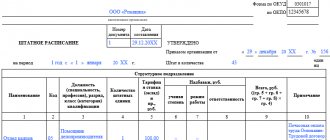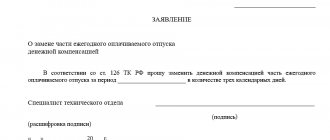Wages (employee remuneration) - remuneration for work depending on the qualifications of the employee, complexity, quantity, quality and conditions of the work performed, as well as compensation payments (additional payments and allowances of a compensatory nature, including for work in conditions deviating from normal, work in special climatic conditions and in areas exposed to radioactive contamination, and other compensation payments) and incentive payments (additional payments and incentive allowances, bonuses and other incentive payments). Part lost force on September 1, 2007 - Federal Law of April 20, 2007 N 54-FZ.
Tariff rate is a fixed amount of remuneration for an employee for performing a standard of work of a certain complexity (qualification) per unit of time, without taking into account compensation, incentives and social payments.
Salary (official salary) is a fixed amount of remuneration for an employee for the performance of labor (official) duties of a certain complexity for a calendar month, excluding compensation, incentives and social payments.
Basic salary (basic official salary), basic wage rate - minimum salary (official salary), wage rate of an employee of a state or municipal institution carrying out professional activities in the profession of a worker or position of an employee, included in the corresponding professional qualification group, excluding compensation, incentives and social payments.
Compensation and wages
The Labor Code of the Russian Federation in Article 129 synonymizes the concepts of “remuneration” and “wages” and defines them as a set of three elements:
| 1. remuneration for work | main (mandatory) part |
| 2. compensation | |
| 3. incentive payments | additional part |
Are compensation and incentive payments taken into account when paying for work on days off and non-working holidays ?
However, it is worth considering that not all components are required to be paid to the employee.
Monthly earnings cannot be lower than the minimum wage level established by the Government, and includes allowances for the complexity of the work and special conditions (work on weekends, etc.). But incentives remain at the discretion of the employer and are awarded only if the employee has done his job well, in the opinion of the employer.
As a result, it turns out that the concept of remuneration is broader than the concept of wages, because is a list of all the elements from which the wages of a particular employee are subsequently collected.
Each employer decides independently how to pay wages, taking into account the minimum provisions of the Labor Code.
Is labor legislation violated if employees are paid less than the minimum wage and are also paid a monthly bonus ?
Art. Art. 23 and 132 of the Labor Code establish the impossibility of discrimination against workers with equal qualifications, output and quality of work. This means that you cannot set different pay for the same work.
Accordingly, the employer must apply uniform parameters when setting wages. A variation of such parameters represents a remuneration system. It must be based on legal norms and not worsen the employee’s position in comparison with them.
Organization of remuneration: how to choose a convenient and effective system
Each of the currently existing forms of remuneration has certain advantages and disadvantages. For example, under “piece-work” conditions, an employee is interested in increasing output and is ready to work with maximum productivity, but the pursuit of the quantity of products produced can negatively affect its quality. Conversely, time-based payment reduces the costs of product quality control, but at the same time reduces labor productivity, and wages become more difficult to link with the final result. For both the employee and the employer, not only the final amount of earnings matters, but also the procedure for its formation.
To decide on the scheme by which the company’s employees will be paid, and to choose the most profitable option, take a two-day master class from experts in the field of personnel accounting and personnel work. You will learn exactly how remuneration systems differ from each other (briefly and clearly), how to optimize the salary fund and minimize costs, what opportunities the summarized recording of working hours opens up for the employer, and what difficulties may be encountered in the process of transition to a new accounting regime.
| Advice Specify the chosen method of settlements with personnel in local regulations: regulations on wages and bonuses, internal labor regulations, collective agreement. |
It is very important that the organization of remuneration at an enterprise is based on principles that are as transparent and understandable to staff as possible. Only in this case will each employee know what exactly he must do to achieve the required result, and will be able to determine the final amount of his salary. If the system used by the employer is too complex and confusing, and the criteria by which labor costs are assessed are not clearly defined, staff motivation will be low, as will labor productivity.
Forms of remuneration
Do not confuse the concepts of “payment system” and “form of payment” - they are not identical, although in the literature they replace each other.
A system is a set of rules for remuneration. Form is one of these rules.
Art. 131 of the Labor Code of the Russian Federation establishes two forms in which labor can be paid:
- Cash – made in rubles.
- Non-monetary - in kind - paid in any material or immaterial form not prohibited by law. The size of the natural part is no more than 15% of the person’s entire salary.
How to reflect in accounting the remuneration of an employee in kind (with the organization’s own products)?
Pay systems
The remuneration system is a documented “instruction” on how to calculate an employee’s salary for a specific period worked, containing a complete list of parameters for the accrual and deduction of funds.
The employer, depending on the nature of the business activity, can use wages to increase output and/or reduce costs. To do this, you need to choose rational remuneration systems.
How can an organization switch to a new remuneration system ?
There are 3 main systems, divided into many types. For clarity, they are all presented in the table below.
| 1. Tariff system | Time-based |
|
| Piecework |
| |
| 2. Tariff-free | ||
| 3. Mixed |
| |
Collect and listen to feedback
This is the most important thing - not to adhere to the rules that were once established, but to change them in accordance with the environment. After all, anything can happen - KPIs will change, employees will work more, prices in stores will increase everywhere. And the previous salary will no longer suit people.
To find out in time that something needs to be changed, periodically ask employees whether they are satisfied with the remuneration system. This is possible not in person, but through anonymous feedback forms: for example, in Google Forms. It will be easier for employees to talk about real problems without revealing their identity, and you will receive objective assessments.
Don’t forget to collect feedback from department heads as well. They may not be comfortable preparing multiple reports or calculating salaries using different formulas. Your task is to make everyone feel comfortable, then both managers and ordinary employees will do the most useful thing for the company.
Tariff system of remuneration
Tariff SOT is the most common, used by both government agencies and commercial organizations. It is based on the ranking of employee salaries depending on their qualifications, work experience, acquired skills, output, conditions and nature of work. In government agencies, the Unified Tariff Schedule is used. In commercial ones - documents similar to it, approved taking into account the opinion of the trade union body.
Tariffing is regulated by law for many industries. For example, for employees in the education sector, an individual tariff SOT has been established in accordance with Government Decree No. 583 dated 05.08.2008.
There are two types of tariff systems: piecework and time-based.
Time-based form of remuneration
Time-based SOT is used at those enterprises where there is no need or opportunity to normalize production. Employees' job functions do not include the production of goods or services, so it is optimal to pay wages for time, and not for the amount of work. Almost all administrative and economic personnel “sit” on this COT. Payment will be made based on the employee’s qualifications and actual time worked in the accounting period.
Peculiarities of salary calculation for different types of time-based wages
With a simple time-based wage, the time worked in the period is paid. Periods can be recognized as: hours, days, months and variations of these periods.
With a bonus , a bonus for the quality of work is added to the salary for time, calculated as a percentage of the salary at the rate. The bonus may be one-time or applied on an ongoing basis.
With a salary , the employee has the right to count on a monthly salary in the amount as established in the employment contract. Upon achieving a certain qualification (determined subjectively by the employer), the salary may be increased.
Cash payments
Convention No. 95 of the International Labor Organization, ratified by the USSR in 1961, proclaimed the principle of payment of wages in banknotes that have legal circulation in the country of the employer. The same principle is also established by the Constitution of the Russian Federation (Article 75), the Civil Code of the Russian Federation (Article 140) and the Law of the Russian Federation “On the Bank of Russia”. That is, based on the meaning of the provisions of the law, the currency of wages in the Russian Federation is the Russian ruble.
Naturally, the question arises whether the legal requirement in this case is prescriptive. In fact, the above-mentioned regulations, while establishing the Russian ruble as the currency of wages, do not prohibit or restrict the use of the currencies of other countries, provided that this currency has legal circulation on the territory of the Russian Federation.
Adherents of the “ruble salary” usually use Letter No. 1688-6-1 of the Federal Service for Labor and Employment dated October 10 as an argument. 2006, which expresses an opinion regarding the illegality of paying wages in a currency other than Russian rubles. From our point of view, the Federal Service for Labor and Employment is not a body with the right of normative interpretation. And as an administrative interpretation, the said letter should be considered solely as a recommendation.
Thus, due to the literal interpretation, wages to employees can be paid in the currency agreed upon by the parties to the employment contract.
Piece wage system
Piece work is used by organizations that provide services, perform work, or produce goods. Their profit directly depends on the speed of their employees’ work, so it is profitable to pay not per unit of time, but per unit of output. The payment formula is as follows: as much as you did, you received as much. The quantity of the product is multiplied by the unit price (piece rate). Such SOT encourages employees to constantly improve their output and quality of work. The second indicator is no less important, because Salaries are calculated based on the results of the period strictly after analyzing the work. Those. if Petrov produces 200 parts, of which 100 are unusable, only 100 will be paid for.
The basis for calculating wages will be documents confirming that employees have fulfilled their personal production plan. In order to facilitate calculations and minimize errors, it is necessary to carefully consider the system for recording employee performance.
How labor is paid for different types of piecework wages
With direct payment, payment is made for the number of units of output at the same price for each.
With progressive - the piece rate increases for each unit above the plan.
With a bonus , a bonus is added to the salary calculated according to the direct piece-rate system for fulfilling the plan, compressing deadlines, absence of defects, economical material consumption, etc.
With indirect payment, the work of support staff is paid, the amount of payment is set as a percentage of the salary of the main employee.
With a lump sum salary, the salary is accrued for the comprehensive implementation of the plan in general; the unit of output in this case does not play a role. There are:
- individual piecework SOT - salary for achieving one’s own indicators;
- collective - the salary of one person depends on the successful achievement of goals by the entire team. This system develops team spirit in the team.
Make payroll an open process
This is one of the motivating factors, and a very important one. If employees understand how and what the company pays them for, they will be able to work more efficiently. And they themselves will manage their working time in such a way as to solve important tasks first.
There are different ways to disclose payroll information. For example, give employees access to a monthly report that includes their KPIs. And tell us exactly how they affect salaries. Or simply post in the work chat the formula by which you calculate your salary.
In this case, it is advisable to do everything so that unnecessary problems do not arise:
- if you prepare a salary report every month for each employee, it will be difficult, time-consuming and expensive;
- If you publish the salaries of all company employees from different departments in one document, this can lead to conflicts.
It’s better to either make the process so transparent that people can calculate their approximate income level themselves, or divide the reports into groups. For example, one report is for one department, where employees work according to the same KPIs.
There are companies that have different remuneration systems for different employees. At the same time, everything is transparent and fair. Alexander Vysotsky , founder of Visotsky Consulting, told us about his experience:
“In my company, the payment system is slightly different for employees working online and in the office. Office employees receive a constant salary that does not change, a percentage of the company’s profit, which is calculated according to a coefficient (this percentage depends on the position held, each employee can calculate this part of the remuneration, since they see the company’s profit weekly), a bonus or an increase for productivity ( the size of the bonus is determined by the contribution, it is regulated by the director of the unit, the results are submitted by the managers). Employees who work online receive an hourly rate (we keep track of time in Time Doctor, and employees can see how much they receive), a fixed bonus (not all employees receive it, but only administrative staff, it is determined by agreement, he too predictable), bonus or bonus for productivity. Payroll calculations are included in our company’s financial model and are calculated automatically. Only the bonus or productivity bonus is distributed manually.”
In PlanFact, some of the data is also open. Igor Boev tells how everything happens:
“Employees working on KPIs enter intermediate results into special tables during their work. This way they see in real time how the obtained indicators change the bonus part of the salary. Within the department, this data is open, and everyone strives to grow faster by looking at the leaders. This is very stimulating to learn from experience and help each other.”
Tariff-free wage system
The tariff-free SOP is similar to the option system in startups. There is a payroll and employees. Let’s assume 100 thousand rubles and 10 people. The employer establishes that:
- The payroll can be increased if the company’s profits rise,
- The share of each employee’s salary is 10%.
The share can rank employees by the amount of participation in work or be the same for everyone.
In the employment contract, of course, they will write down 10 thousand rubles - salary per month. It is impossible to mention % according to the Labor Code, and it is not very profitable for the company.
After the announcement of working conditions, there is no need to establish additional incentives; employees themselves will strive to increase the company’s income. This model is applicable to small, start-up companies that will not go public, but want to interest employees without having money for bonuses.
Use software to calculate and payroll
This will free up resources. The accountant will not drown in “receipts” every month, but will do something else. Automation will allow you to collect and process information about employee salaries on one screen, rather than switching between different reports or flipping through a bunch of papers.
You can automate payroll calculations and calculations using different methods and tools. For example, introduce self-reporting for employees: let them count themselves how much they did or worked this month. Or start using CRM systems in which the activity and efficiency of each employee will be visible. At the end of the month, you can simply download the report from CRM and give it to an accountant for processing - without unnecessary red tape and calculations.
Many people do this. Igor Boev says about automation :
“Our payroll system is approximately 80% automated - as much as possible in 1C. But 20% of manual labor still remains, mainly for calculating the bonus component. These calculations are carried out by the accounting department, based on data from department heads."
Mixed remuneration system
A mixed SOT combines tariff and non-tariff SOT - the employee has a certain salary, but in this case it directly depends on the success of his work: on the number of sales, on the quality of developments, on time worked, etc.
The more output, the higher the salary. And vice versa. The difference from the tariff is that the entire salary is reduced down to the minimum wage.
How are salaries calculated for different types of mixed labor protection?
The floating salary system involves recalculating salaries on a monthly basis based on the results of work for the previous period.
In commission calculations, an employee can count on a percentage of the company’s profit in general, or from each unit of output. This COT is very often used in insurance companies.
Payment for labor in a dealer network is very close to payment under a civil contract, but it also occurs in labor law. An employee is obliged to sell a certain amount of company goods, which he purchases at his own expense. The difference between the purchase price and the selling price to third parties is the person’s wages.
Motivate employees with salary
According to a Hays study from 2021, 93% of employees consider decent monetary remuneration a factor in material motivation. Another 66% say they are motivated by bonuses for achieving their goals.
That is, in order for employees to want to work better, you need to provide them with a normal salary - not lower than the market average. And also choose a system in which everyone can earn a little more. For example, you can:
- award bonuses to all employees if the company’s financial performance improves;
- pay for work according to KPI;
- pay twice as much for overtime or weekend work as usual.
Salary level is important, but it is also a short-term motivator. Do not forget that intangible factors are no less important. Read what we have already talked about ways to motivate employees in a small business - you will find out how else you can get people interested in work.
At the same time, some entrepreneurs believe that it is payment according to KPI that serves as the main motivating factor. For example, this is the position of Maxim Mezhenkov , development director of the My Auto Rental car rental network:
“There is always a fixed part in the salaries of our company’s employees, and there are KPIs. The manager’s task is to build a delegated process. There should always be a KPI. No KPI - no results. And not only in sales. And if you cannot formulate an employee’s KPI, then the problem is in your ability to organize the process. It is important to immediately describe in as simple a language as possible why the employee goes to work. What are the objective measurable results of his work? The salary must include a certain number of units of result per unit. At the same time, the KPI bar should be progressive. The more results per unit of time, the higher the employee’s payment for each unit. It is better not to limit KPIs from above. An employee must understand that there is no ceiling on his result, and the result depends only on him. The higher an employee “jumps” within a month, the more he takes home. Whether a KPI is quantitative or qualitative depends on the organization and position. The closer to the mass market, the better the quantitative. The higher you go to the premium segment, the more important quality is. The salary of a sales manager directly depends on the number of transactions, an account manager - on the number of applications collected by him, and an SEO specialist - on the number of positions gained in search results. Nobody works without carrots"
Others believe that tangible motivational factors are important, but intangible ones are also worth paying attention to. Igor Boev told how everything happens in the PlanFact team:
“For effective and friendly team work, it is important to combine a flexible remuneration system and a non-material motivational component. We try to organize a comfortable workplace: a comfortable office, a fast computer, two monitors for those who find it more convenient. In 2021, we created a relaxation room where you can relax during a break. We host corporate events: volleyball, laser tag, karting, bowling, horse riding, outdoor barbecues, board games. As a rule, the company covers most of the entertainment costs. It is also important that every employee feels care and attention from management. For example, I often talk with employees and find out what they are not happy with. 1-2 times a year we conduct online surveys of the team, assess job satisfaction, take into account wishes and, if possible, change something"








